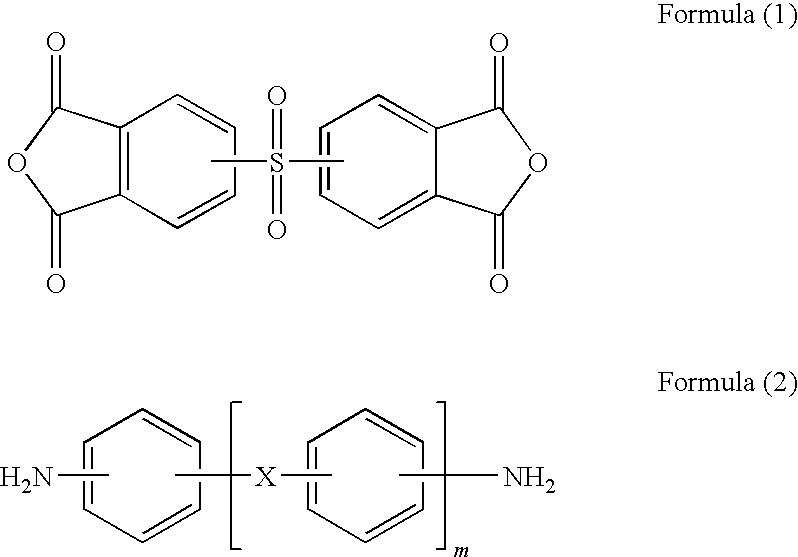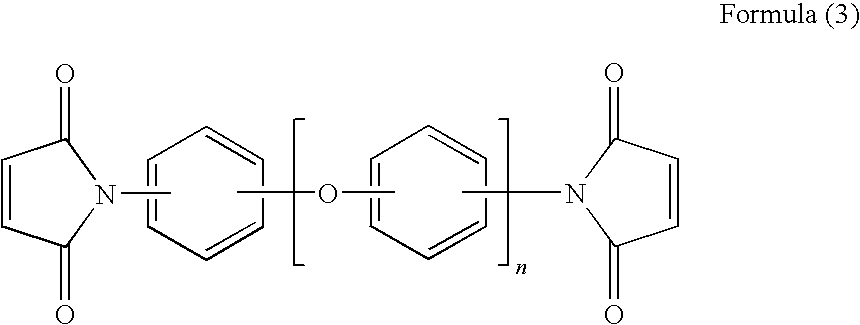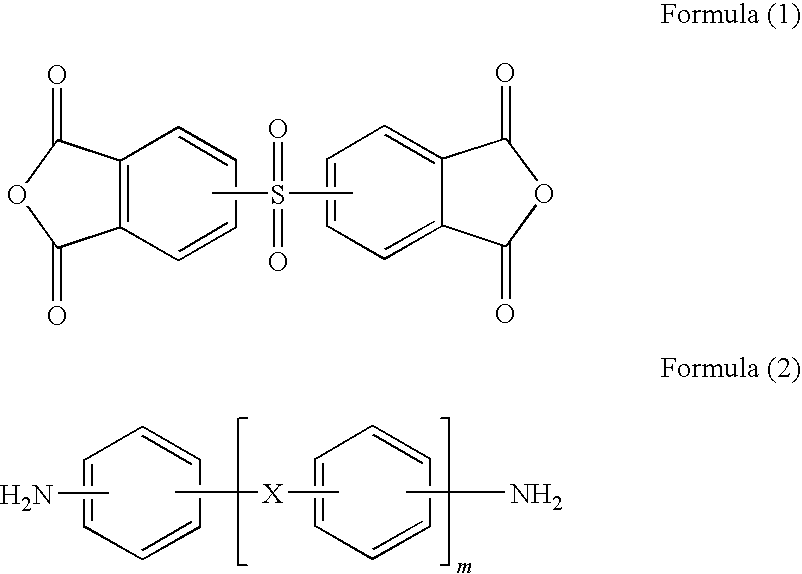Resin composition and metal laminate plate
a technology of metal laminate plate and resin composition, which is applied in the direction of synthetic resin layered products, transportation and packaging, other domestic articles, etc., can solve the problems of difficult removal of such a smear, the problem of not being able to solve the problem of desmear process as described above, and the smear was hardly removed in the desmear process
- Summary
- Abstract
- Description
- Claims
- Application Information
AI Technical Summary
Benefits of technology
Problems solved by technology
Method used
Image
Examples
example 1
[0047]Into a vessel provided with a stirrer and a nitrogen inlet tube was added 243 g of DMAc as a solvent. Thereinto were added 10.27 g of ODA and 15.00 g of APB as diamine compounds in order that the molar ratio of ODA to APB was 50:50. The resulting mixture was stirred at room temperature until it was dissolved. Then, 32.26 g of DSDA and 3.22 g of BTDA were added in order that the total acid anhydride components had the molar ratio of 0.975 based on 1 of the total diamine components and the molar ratio of DSDA to BTDA was 90:10. The resulting solution was stirred at 60° C. to obtain a polyamic acid solution with the polyamic acid content of 20% by mass. In order to have the mass ratio of APB-BMI of 20% in the solid content of the polyamic acid of varnish obtained, 15.19 g of APB-BMI was added. The resulting solution was stirred at room temperature until it was dissolved to obtain a polyamic acid solution containing a bismaleimide compound. The obtained polyamic acid solution was ...
examples 2 to 19
[0049]Examples 2 to 19 were conducted in the same manner as in Example 1, except that the kind and ratio of the diamine compound, the kind and ratio of the acid anhydride, and the APB-BMI content relative to the solid content of the polyamic acid were changed to those shown in Table 1. The results were shown in Table 1.
synthesis example 1
[0051]Into a vessel provided with a stirrer and a nitrogen inlet tube were introduced 19.58 g (67 mmol) of 1,4-bis(4-aminophenoxy)benzene, 8.20 g (33 mmol) of 1,3-bis(3-aminopropyl)-1,1,3,3-tetramethyldisiloxane, 35.83 g (100 mmol) of 3,3′,4,4′-diphenylsulfone tetracarboxylic dianhydride, and 300 ml of NMP at an ice temperature in order that the molar ratio of 1,4-bis(4-aminophenoxy)benzene to 1,3-bis(3-aminopropyl)-1,1,3,3-tetramethyldisiloxane was 67:33, and the resulting mixture was continuously stirred for 1 hour. Subsequently, this solution was reacted at room temperature for 2 hours for synthesizing a polyamic acid. To the obtained polyamic acid were added 50 ml of toluene and 1.0 g of p-toluene sulfonic acid, and the resulting mixture was heated at 160° C. While water azeotroped with toluene was separated with the progress of the reaction, an imidization reaction was carried out for 3 hours. Then, toluene was removed and the thus-obtained polyimide varnish was flowed into met...
PUM
| Property | Measurement | Unit |
|---|---|---|
| molar ratio | aaaaa | aaaaa |
| thickness | aaaaa | aaaaa |
| thickness | aaaaa | aaaaa |
Abstract
Description
Claims
Application Information
 Login to View More
Login to View More - R&D
- Intellectual Property
- Life Sciences
- Materials
- Tech Scout
- Unparalleled Data Quality
- Higher Quality Content
- 60% Fewer Hallucinations
Browse by: Latest US Patents, China's latest patents, Technical Efficacy Thesaurus, Application Domain, Technology Topic, Popular Technical Reports.
© 2025 PatSnap. All rights reserved.Legal|Privacy policy|Modern Slavery Act Transparency Statement|Sitemap|About US| Contact US: help@patsnap.com



